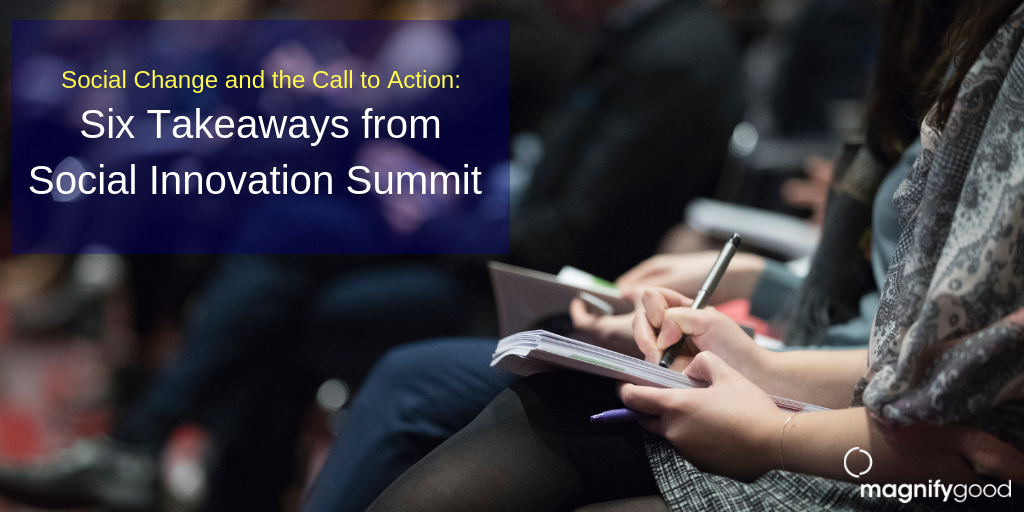More than a philosophy or theory, social innovation is a call to change the world by taking action. That was the theme at the Social Innovation Summit in Silicon Valley, a place that is well known for incubating innovators. In collaborative and creative settings alike, social innovation demands changemakers take action by cultivating an environment where they can live, learn and grow. The takeaways from day one of the conference were plentiful and poignant akin to the leaders who presented them.
1. Collaborate until it hurts
Collaboration is more than friendly nods and a willingness to sit down with others. It is a discipline that can make a person uncomfortable, as your beliefs and conclusions can be challenged.
“When we are uncomfortable, we learn and grow.” – Caroline Barlerin
In an organization setting, bringing together multiple team players in an effort to reach the same goal might be painful at first, but it’s often a necessary part of growing and opening yourself up to newer, better possibilities.
Collaborate until it hurts. If it doesn’t hurt, you’re not collaborating @blairtaylor @socinnovation pic.twitter.com/z9NWEG36Ep
— Anne (@anne_emig) June 5, 2018
2. Take action now
Nearly every speaker and panel participant spoke with the same refrain, that social innovation is not a future project or a world of tomorrow. It is a call to action today, and a personal decision to begin, possibly without a plan but with a determination to try, to accept failures, and to continue to move on.
“We don’t need to wait our turn; our turn is now” – Emily Cherniack
3. Make a life, not a living
To be active in the world as a changemaker means to accept it as a lifestyle, not a job. Social innovation, and the motivation to accept it as a mantra for yourself, is a pathway to learning and growing as an individual.
4. Maintain an ethical balance
Microsoft’s Shelley McKin outlined six principles of ethics for AI that can apply to all of social innovation: Fairness, Reliability & safety, Privacy & security, Inclusiveness, Transparency, and Accountability. That ethical balance helps build confidence and strengthens resolve when faced with difficult choices.
6 principles for ethics of AI:
Fairness
Reliability & safety
Privacy & security
Inclusiveness
Transparency
AccountabilityMicrosoft’s @shelleymckin, who presented this morning at @socinnovation #sis18, says the most important is INCLUSIVENESS. 🙌🏾 pic.twitter.com/p64Q5g5ueo
— sree sreenivasan 谢瑞睿 (@sree) June 5, 2018
5. Exercise your creativity
Innovation requires creativity, a form of self-improvement that is essentially not only free-thinking but in stimulating that part of the brain through “exercise.” It was best described as a “soft mind” or a muscle to be nurtured, sometimes by reflection and other times by stimulation.
Creativity is a muscle… cultivate a practice of random input, reflection to do nothing, take notes, access to tools, create a stimulating environment and focus on mentorship — @brentbushnell of @twobitcircus #sis18 pic.twitter.com/iKoYDE7Guz
— Social Innovation Summit (@socinnovation) June 5, 2018
6. Leverage social capital
The use of capital for social change is more than an investment of dollars for good, or as one presenter noted, “”We use all our forms of capital, including non-financial capital, to create sector change.”
Blair Taylor said companies are willing but unprepared to tackle social issues. Agreed and I think one success factor is a strategy for reaching increasingly tribal stakeholders in a low-trust environment #SIS18
— joeymarquart (@joeymarquart) June 5, 2018
As with most conferences, the personal payoff can come from knowledge, an exchange of ideas and experiences, or from a deeper, more emotional return. More than satisfying personal gains or satisfaction, the ability to engage and learn more about social innovation pays off at the tribal level, within our communities, whether by occupation, geography, or cause.
The 2018 Social Innovation Summit gathered in Silicon Valley, California on June 4-6. During this conference, innovators and disruptors have a platform to share unique concepts and empower each other to go forth and change the world around them.



